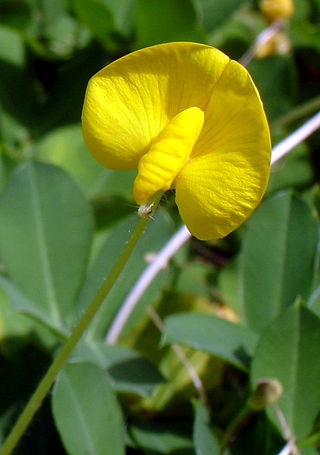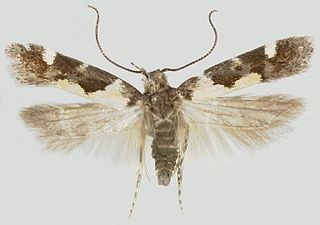
The peanut, also known as the groundnut, goober (US), pindar (US) or monkey nut (UK), is a legume crop grown mainly for its edible seeds. It is widely grown in the tropics and subtropics, important to both small and large commercial producers. It is classified as both a grain legume and, due to its high oil content, an oil crop. World annual production of shelled peanuts was 44 million tonnes in 2016, led by China with 38% of the world total. Atypically among legume crop plants, peanut pods develop underground (geocarpy) rather than above ground. With this characteristic in mind, the botanist Carl Linnaeus gave peanuts the specific epithet hypogaea, which means "under the earth".

Arachis is a genus of about 70 species of annual and perennial flowering plants in the family (Fabaceae), native to South America, and was recently assigned to the informal monophyletic Pterocarpus clade of the Dalbergieae. At least one species, the peanut, is a major food crop species of global importance; some of the other species are cultivated for food to a small extent in South America. Other species such as A. pintoi are cultivated worldwide as forage and soil conditioner plants, with the leaves providing high-protein feed for grazing livestock and a nitrogen source in agroforestry and permaculture systems.

Arachidyl alcohol, also 1-icosanol, is a waxy substance used as an emollient in cosmetics. It is a straight-chain fatty alcohol with 20 carbon atoms, typically obtained via the hydrogenation of arachidic acid or arachidonic acid, both of which are present in peanut oil. Its name is derived from that of the peanut plant.
Arachis ipaensis is a herb in the Faboideae subfamily. This plant is cited as gene sources for research in plant biology of peanut. Its genome has been sequenced.
Arachis archeri is a herb native to Mato Grosso vegetation in Brazil. This plant is cited as gene sources for research in plant biology of peanut.
Arachis batizocoi is a herb native to Bolivia and Paraguay. This plant is cited as gene sources for research in plant biology of peanut. Arachis batizocoi maintains a divergent genome as well as high fertility that facilitates the upbringing of new and beneficial alleles within peanut crops. Such high crossability has increased the frequency of several advantageous alleles that have improved plant life and agricultural output. Among these are boosted resistance against groundnut yield-limiting diseases such as late leaf spot (LLS) and groundnut rosette disease (GRD), larger seeds, and a higher overall yield.
Arachis cardenasii is a herb in the Fabaceae family. This plant is cited as gene sources for research in plant biology of peanut ; for example, Cercospora leaf spot resistance.
Arachis correntina is a herb native to Argentina and Paraguay. This plant is cited as gene sources for research in plant biology of peanut.

Arachis duranensis is a herb found in South America, specially in North Argentina, Bolivia, and Paraguay. This plant is cited as gene sources for research in plant biology of peanut.
Arachis villosulicarpa is a perennial peanut species, which is cultivated by indigenous people in Mato Grosso, a state of Brazil. Its wild progenitor is thought to be Arachis pietrarellii. Although it is related to the common peanut, Arachis hypogaea, it was separately domesticated: A. villosulicarpa is diploid, whereas A. hypogaea is tetraploid.

Arachis glabrata is a high-quality forage plant native to Argentina, Brazil, and Paraguay vegetation. This plant is also used for soil conservation and as an ornamental plant.
Bean yellow mosaic virus is a plant pathogenic virus in the genus Potyvirus and the virus family Potyviridae. Like other members of the Potyvirus genus, it is a monopartite strand of positive-sense, single-stranded RNA surrounded by a capsid made for a single viral encoded protein. The virus is a filamentous particle that measures about 750 nm in length. This virus is transmitted by species of aphids and by mechanical inoculation.

Peanut mottle virus(PeMoV) is a pathogenic plant virus of the family Potyviridae. As with other members of this virus family, PeMoV is a flexuous filamentous virus with particles 740–750 nm long. It is transmitted by several species of aphids and by mechanical inoculation. It was first given its name in 1965 when it was isolated from peanuts (Arachis hypogaea) in Georgia, United States. The virus was found to be seed transmitted in its host.
Antonio Krapovickas was an Argentine agronomist.

Arachis pintoi, the Pinto peanut, is a forage plant native to Cerrado vegetation in Brazil. It is native to the valleys of the upper São Francisco and the Jequitinhonha rivers of Minas Gerais. It has been named after the Brazilian botanist Geraldo Pinto, who first collected the plant at the locality of Boca do Córrego, município de Belmonte in 1954 and suggested its potential as a forage. The species has been first described by A. Krapovickas and W. Gregory in 1994.

Stegasta bosqueella is a species of moth of the family Gelechiidae. It is found in North America, including Alabama, Florida, Georgia, Illinois, Iowa, North Carolina, Oklahoma, South Carolina, Texas and Virginia.

Rajeev Kumar Varshney is an Indian agricultural scientist, specializing in genomics, genetics, molecular breeding and capacity building in developing countries. Varshney is currently serving as Director, Western Australian State Agricultural Biotechnology Center; Director, Centre for Crop & Food Innovation; and International Chair in Agriculture & Food Security with the Food Futures Institute at Murdoch University, Australia since Feb 2022. Before joining Murdoch University, Australia he served International Crops Research Institute for the Semi-Arid Tropics (ICRISAT), a global agriculture R&D institute, for more than 16 years in different scientific and research leadership roles including Research Program Director for three global research programs– Grain Legumes, Genetic Gains and Accelerated Crop Improvement Program. He has the onus of establishing and nurturing the Center of Excellence in Genomics & Systems Biology (CEGSB), a globally recognized center for genomics research at ICRISAT that made impacts on improving agriculture and development of human resources in several countries including India, China, Kenya, Ethiopia, Tanzania, Nigeria, Ghana, Mali, Senegal, Burkina Faso, etc. Varshney holds Adjunct/Honorary/Visiting Professor positions at 10 academic institutions in Australia, China, Ghana, Hong Kong and India, including The University of Western Australia, University of Queensland, West Africa Centre for Crop Improvement, University of Hyderabad, Chaudhary Charan Singh University and Professor Jayashankar Telangana State Agricultural University.
Joseph ("Joe") Smartt, was a British geneticist with major contributions to the knowledge of crop evolution, especially of grain legumes.








